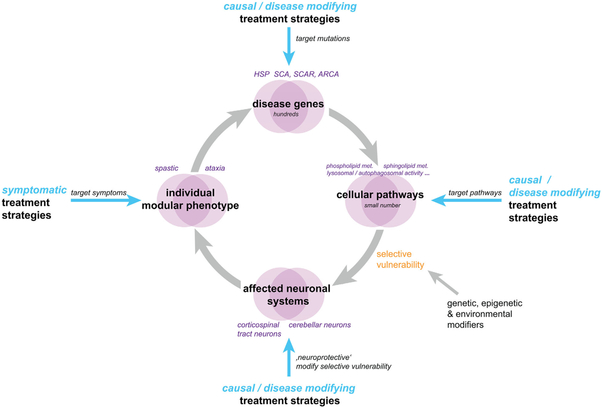FIG. 1.
From clinical diagnosis to modular phenotyping and underlying shared genes and pathways in ataxia-spasticity spectrum diseases. Ataxias and HSPs have traditionally been designated in separate clinicogenetic disease classifications, depending on the first phenotypic descriptions and pattern of inheritance, namely, either in autosomal-dominant spinocerebellar ataxias (SCAs) and autosomal-recessive spinocerebellar ataxias (SCARs) or hereditary spastic paraplegias (HSPs/SPGs). However, the molecular etiologies of these 2 disease groups overlap greatly, based on manifold shared disease genes (top). Moreover, proteins encoded by HSP and ataxia genes closely interact physically as well as functionally. The heterogeneous genetic etiology of HSPs and ataxias thus converges into a small number of cellular pathways that are dysregulated in both diseases (right). Selective vulnerability of specific neuronal cell types that can be modified by additional genetic, epigenetic and environmental factors ultimately determines which neuronal systems and circuits will be affected by the pathway dysfunction (bottom). In ataxia-spasticity spectrum diseases, cerebellar and corticospinal tract neurons share selective vulnerabilities. The individual phenotypic expression (left) is a result of the pattern of neuronal system affection. It is essential to appreciate these 4 aspects, not only to understand an individual’s disease, but also to use all therapeutic routes, whether they be symptomatic or causal/disease modifying. Pathway-based treatment approaches are hereby particularly promising, as (1) they offer the potential to cure, not only to modify the disease condition, with the (2) pathway-based etiologies partly converging from the vastly heterogeneous genetic etiology. Targeting dysfunctional pathways rather than single genes or disease conditions thus has the potential to address whole groups of genetically defined ASS diseases. [Color figure can be viewed at wileyonlinelibrary.com]

